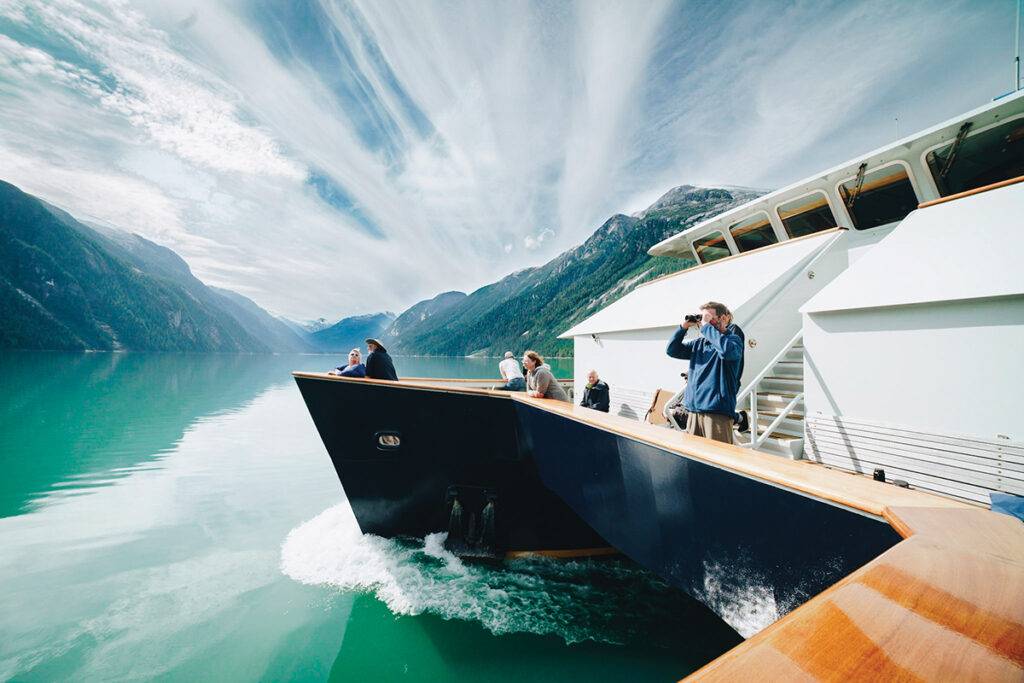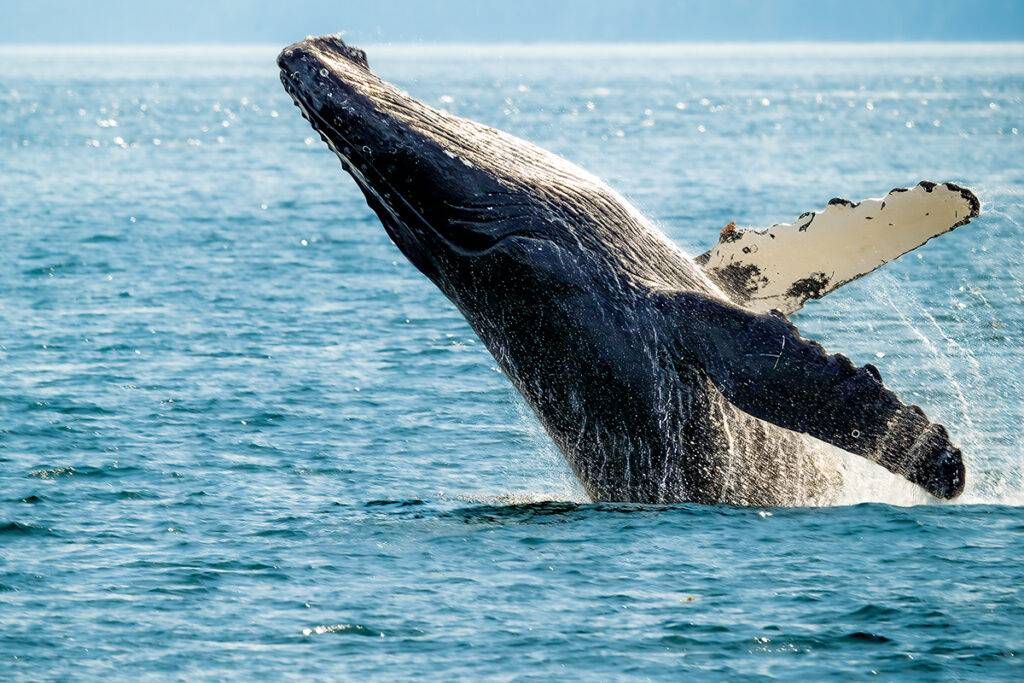Connecting with wild nature in the Great Bear Rainforest, an ecological treasure in our own backyard.
BY LINDA BARNARD

Our boats drifted silently in the early-morning gloom of the Great Bear Rainforest. We squinted and raised binoculars and cameras, trying to make out the shapes on the beach.
Was that a sea wolf lying on the white sand? Two sea wolves? Oh boy — pups!
We were up before dawn to board a pair of 10-passenger tenders from Maple Leaf Adventure’s 138-foot expedition catamaran Cascadia. We hoped to spot the sea wolf, a rare marine species unique to the Great Bear Rainforest and certain corners of the Pacific Northwest. It lives primarily on seafood. Remarkably, it swims to get it.
Three sea wolves trotted from the rainforest, along the rocks and onto the beach to rest, forage and play, joining the others in spine-tingling, pitch-changing howls. Another wolf slipped into the ocean from a rocky islet several metres from our small boats. It swam strongly to join the pack onshore, shaking the water from its coat in a way familiar to all dog lovers.
And all this happened before I’d had my first cup of coffee. But that’s just the kind of magical moment you come to expect on a journey to this unique place.

Fragile, Natural Beauty
The Great Bear Rainforest doles out natural wonders lavishly. This protected place of fragile, natural beauty along the northern coast of British Columbia covers an area about the size of the Republic of Ireland. Home for millennia to the First Nations, it includes the Kitlope, called Xesdu’wäxw, the largest contiguous tract of protected temperate rainforest on the planet, where thousand-year-old trees tower above streams and rivers rich with wild salmon.
We’re lucky to have this remarkable place in our B.C. backyard, although exploring the crinkled coast of the Great Bear Rainforest takes some planning. There are no through roads or large cruise ships. The only way to experience the fjords, islands, rainforest and silence is by water on a small vessel.
Victoria-based ecotourism company Maple Leaf Adventures has been bringing curious travellers to the Great Bear Rainforest, as well as Haida Gwaii, northwest Vancouver Island and Alaska, since 1987. Cascadia is the largest and newest of the three Maple Leaf vessels.
Company co-presidents Kevin Smith and Maureen Gordon run small-ship experiences that travel lightly on the land and water, leaving no trace. They support regional communities, are key players in annual shoreline debris cleanup projects and follow protocol agreements with Indigenous stakeholders.
Smith is an experienced mariner and onetime backcountry park ranger whose love of the Great Bear Rainforest is palpable. As expedition leader on our trip, he told us we were about to enter “a unique, very, very special corner of this one blue planet.”
We’re lucky to have this remarkable place in our B.C. backyard, although exploring the crinkled coast of the Great Bear Rainforest takes some planning.
There were 18 passengers from the United Kingdom, Germany, the United States and Vancouver Island on board the 12-cabin Cascadia. One couple travelled with their curious kids, who had fishing licences, which meant we had freshly caught Dungeness crab for dinner one night.
Cascadia felt roomy and comfortable, with an outdoor room on the rear deck plus a window-lined salon that was our lounge, dining room and hangout hub. The twin hulls made for a smooth voyage. The affable crew of 10, primarily from Vancouver Island and the Lower Mainland, included Toronto-based chef Pete Keegan, sous chef Mara Jernigan and naturalist Janet Winbourne.
If I wasn’t at the railing admiring the scenery and watching for humpback whales or taking a soak in the top-deck hot tub, I loved being in the salon with its well-stocked library of nature and local history books and excellent espresso machine. Because Maple Leaf believes Wi-Fi takes passengers away from the world outside the ship, we played cards and board games instead of being glued to our phones, or tried our hand at watercolours or joined Winbourne at the long dining table to work on a wildlife- and nature-mapping project.
We also got to know each other over hearty meals featuring Vancouver Island cheeses, excellent B.C. wines and sustainable halibut or albacore tuna from Victoria purveyor Finest at Sea. “Fresh food is a given,” said Jernigan, the former president of Slow Food Canada whose lengthy career includes running a cooking school in Italy.
She nailed it when she called Cascadia “a little floating boutique hotel.”

Lessons of the Wild World
We went days without seeing another boat, travelling through deep channels bracketed by glacier-topped mountains, slipping into estuaries and milky blue glacier-fed bays.

When Cascadia was at anchor, its small tender boats made wild spaces accessible. Those of us with temperamental knees were glad for the drop-front bows, which meant we could walk off with ease. The crew were experts at steering the nimble little watercraft, nosing them beneath magnificent waterfalls, where we leaned over the front ramps to fill reusable cups with glacier water, laughing as we toasted each other.
Smith explained the negative ions created by waterfalls are nature’s happiness generator. “Have you ever been unhappy at a waterfall?” he asked.
Winbourne taught us about the wild world, like how salmon are a key to forest health, their carcasses providing most of the nitrogen used by the trees. She helped us safely hold and examine bright purple sea stars and vermilion sea urchins. In the forest, she showed us carnivorous plants, tiny and perfect in their hunting skills.
Two special guests, Haisla First Nation members Louisa Smith and Liz Robinson, shared stories and insights into their culture to help us connect with their traditional territory. One rainy morning, they took us to Smith’s family oolichan camp, where they explained how the fatty, smelt-like fish are processed in a multi-day process to make a health-promoting oil that has been a key trade item for thousands of years.
Our days were dictated by tides, weather and wildlife. As we gathered in the salon for coffee and a pre-breakfast of homemade granola, fruit and yogurt, Smith and Captain Jeff Harvey conferred at an interactive navigational map. We watched them plan the day’s route on the wall-mounted, big-screen TV.
Smith wrote the expected itinerary for excursions, sailings and meals, what he jokingly called “Plan A,” on a white board beside the bar.
If we got waylaid on what Smith dubbed a “tender toodle” up the Kitlope River by a juvenile grizzly bear doggie paddling across an estuary, brown ears bobbing, who wouldn’t want to hang around to watch that?

All We Didn’t Miss
I know I was incredibly lucky to spot the region’s rare sea wolves, but I had also hoped to see the even rarer white-coated black bear known as the spirit or Kermode bear. British Columbia’s official mammal is the handsome star on some licence plates and often used in destination marketing. It isn’t an albino animal; it’s the result of a genetic mutation and only lives in the Great Bear Rainforest, where it has significant cultural meaning for Indigenous people.
Gordon cautioned that focusing too much on seeing a spirit bear could make me miss the other riches the Great Bear Rainforest has to offer. She was right. What we didn’t see hardly mattered.
After all, what we did see was pretty spectacular. How many people are lucky enough to say they’ve seen sea wolf pups in the wild? Captain Harvey called it “W Day” when we followed up the morning sea wolf excursion with a trip along the aptly named Whale Channel. The heart-shaped sprays from humpbacks were so plentiful, we lost count. The animals made slow, graceful arcs out of the water to breathe, their tails rising last. Some humpbacks breached in astonishing displays.
People say they are changed by their time in the Great Bear Rainforest. I keep thinking about a shallow river on a sunny afternoon, where dying pink salmon flopped in the rocky shallows at the end of their spawn and life cycle. They created the next generation and will feed the eagles, grizzlies and the forest with their deaths.
“This place is a perfect system that endures and continues. It will always be here,” Smith said. “When life becomes busy, overwhelming, put yourself here and remember this place.”
If You Go
Three Maple Leaf Adventures small ships sail to the Great Bear Rainforest from April to October. Trips last five to nine days. Rates start at $5,750 per person, based on double occupancy, and include meals, wine and beer. Air fare is extra; passengers must take a 100-minute flight from Vancouver to Terrace, followed by a 45-minute shuttle transfer to the marina at Kitimat, where the ships embark. mapleleafadventures.com

